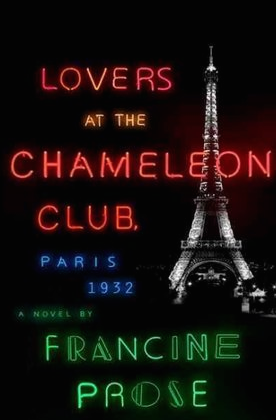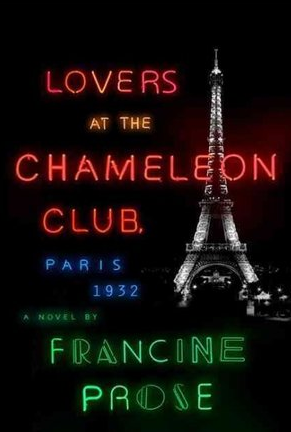Book by FRANCINE PROSE
Reviewed by

Through all these voices we see Paris, or at least a certain underside of it, transform from a place of exuberant self-creation where dark streets offer cover for love affairs and photographers’ fancies to an occupied territory where dark streets are filled with dread and violence. Paris during these decades is richly imagined in Prose’s hands. She relishes depicting the late 1920s and early 1930s in particular, when the main characters are all connected to the Chameleon Club, a nightclub for gays, lesbians, and other gender-bending types (Lou is dancing there, and the others are regulars). One of the book’s pleasures is its conjuring of the rollicking, smoke-filled club and its parade of characters and coarsely choreographed shows:
A girl costumed as Neptune, in a fake beard and trident, sang a scorcher about how lonely it was at the bottom of the sea. Then the lights flickered, cymbals crashed, a gale swept over the ocean, a belly dancer fell off a cardboard ship. She shimmied while Neptune leered, then the two women – the sea “god” and “his” spangled queen – fell in love. Fatima was a genius, as belly dancers go, and everyone missed her when she left to marry a cop from the provinces.
This is the freewheeling jazz-age Paris that we know from photographs by the likes of Eugene Atget, Brassaï, Ilse Bing, Man Ray, and Jacques Henri Lartigue, who portrayed writers, artists, dancers, showgirls, and prostitutes and approached the city’s architectural features (the streetlamps, bridges, gargoyles, steps) as subjects worthy of portraiture. This Paris has been romanticized and recreated in many forms, from movies to merchandise, and it is not hard to imagine why: the artistic achievement of the period is fascinating, the hedonism and eroticism alluring, and the carefreeness undemanding. (The most famous works of art from this period are concerned more with beauty and conceptual cleverness than with social commentary, as if in a collective sigh of relief after the first World War.)
Before long, however, things begin to change, and we see the city wake up to the ugly xenophobia that is gaining ground in the face of mounting political tension and a suffering economy. Police show up at the Chameleon Club and threaten dancers with deportation unless they can scrape together bribes; Lou’s lover, Arlette, pursues the “proto-fascist police chief”; racism gradually creeps into the club. In a particularly good scene, Arlette adds anti-semitic verses to her song and the audience is stunned. Once the tension passes, however, most of the audience is delighted. Yvonne, the owner of the club, does nothing to stop it, and these slight shifts in power – when a joke once laughed at only in private becomes something to be embraced publicly, when it becomes good business to cater to the bigoted – are the way prejudice becomes normalized. Prose observes these moments well.
In the midst of this changing atmosphere, the photographer’s patron, a wealthy Baronness, hires Lou to drive her family’s racecars, and Lou is off on a new and exciting career training, touring, and racing. She takes to this eagerly, much as she took to athletic training as a child, but is eventually barred from competition because she dresses in men’s clothes – emboldened conservative groups protest her style as insufficiently French and a threat to the morality of the nation – and ends up owning a car-repair shop in Paris. During this period she meets a German woman, Inge, who also races cars and who invites her to the 1936 Olympics in Berlin as a personal guest of Hitler. Lou, flattered, finds Germany’s organization and efficiency impressive, and is enamored of Inge. Shortly afterwards, Lou starts to spy for the Germans, eventually delivering important secrets that help them to invade France, and once they have occupied Paris she starts working for the police. We are told that she specializes in interrogation, using her cigarette lighter to torture suspected members of the Resistance, and that she helps to plan the Vel’ d’Hiv roundup, the notorious mass arrest of Jews in 1942.
As a portrait of an evolving circle of people in tumultuous times, the book works well. By reading three accounts of the same event, for example, we learn a great deal about characters’ views, self-conceptions, interests, and prejudices. But it is less clear that the book works as a portrait of Lou, who never quite attains the spark that brings characters to life. In the midst of vivid prose, inventive narration, and dramatic events, Lou comes across as unreflective, passive, and humorless. One challenge is that we never hear from her directly; another is that most of what we know about her comes from Nathalie’s biography, since the other characters mention her only occasionally and there are no writings by the people most intimate with Lou, such as Arlette or Inge. Perhaps most importantly, though, she does not fully drive her own life. She becomes an athlete when Sister Francis invites her to; she ends up at the Chameleon Club because she has been given its card and has nowhere else to go; she begins dancing at the club when Yvonne suggests it; she drives racecars because the Baroness invites her to; she spies for the police in occupied Paris after the police chief asks. To be sure, Lou takes avidly to these endeavors and clearly cares about her performance of them. But she seems never to seek out the next chapter of her life before it is presented to her, and her reasons for doing things rarely go beyond enjoying a pursuit or liking the person who has asked her to do it.
One of Prose’s themes is narrative reliability, and she explores it most obviously by putting narratives of questionable reliability at the center of the book. We learn that the photographer who takes the famous photograph of Lou, Gabor Tsenyi, likes to stage photographs after scenes he has seen or imagined, asking his friends to pose as burglars in the night and photographing patrons of the Chameleon Club in his studio, surrounded by carefully placed props to replicate the interior of the club. Gabor is trying to capture reality through the application of artifice, slowing the world down and lighting it just right so that he can get it on film. Even though this results in misrepresentation – the picture of Lou is titled Lovers at the Chameleon Club, Paris 1932 even though it is taken in his studio – there is a sense in which his photographs succeed in representation nonetheless. The authenticity of Nathalie’s biography of Lou is called into question near the end of the novel when another character accuses it of outright falsehoods.
This twist makes for a jarring ending, but Nathalie has been a worrisome source from the beginning: she seems far too personally affected by her research (“Every night for weeks I dreamed about the photographer Gabor Tsenyi giving Lou Villars the business card of the Chameleon Club”), she tends toward overly dramatic language (“Which of us has not fallen for a heartless automaton pretending to be a human?”), and she freely admits to making a lot of the details up (“I have had to embroider a bit, fill in gaps, invent dialogue, make an occasional imaginative leap or informed guess about what my subject would have thought and felt”). Evidently she has embroidered a great deal, since the biography is filled with a novelistic level of detail – thoughts, extended dialogue, feelings – even though she tells us she was able to gather very limited information about Lou’s life. This is problematic both because she presents her work as a biography and because she aims to uncover what led Lou to do the terrible things she did:
Without claiming too much for my little book, I will only say that I have tried to make my humble contribution to the literature on the mystery of evil.
How could someone, how could anyone, do what Lou Villars did?
If Nathalie’s aim is to understand what might motivate someone to do terrible deeds, how can her invention of Lou’s psychological and emotional states tell her anything new? The extensive novelistic embellishment is self-defeating; it is like trying to understand what led to World War I by reading a few brief sources and then imagining the rest – interesting, perhaps, but of no help in illuminating what leads to a world war.
Like Nathalie, Prose is also writing a book based on a real person about whom there is limited information (Lou and most of the main characters are based on real people). But Prose does not share Nathalie’s aim or her method: she puts forward no explicit psychological task, and she has chosen to craft a work of fiction rather than work within the boundaries of biography. As a result, she is free to fill in the outline of Lou’s life as imaginatively as she likes, and this turns out to be the book’s chief virtue. Even though Lou sometimes remains in the shadows, what shines is Prose’s elegant ability to evoke grand, atmospheric scenes, as well as the small facets of consequential relationships both on the upswing and on the rocks.
Elisa Mai lives in Cambridge, MA. She co-edited What Should I Do? Philosophers on the Good, the Bad, and the Puzzling.




